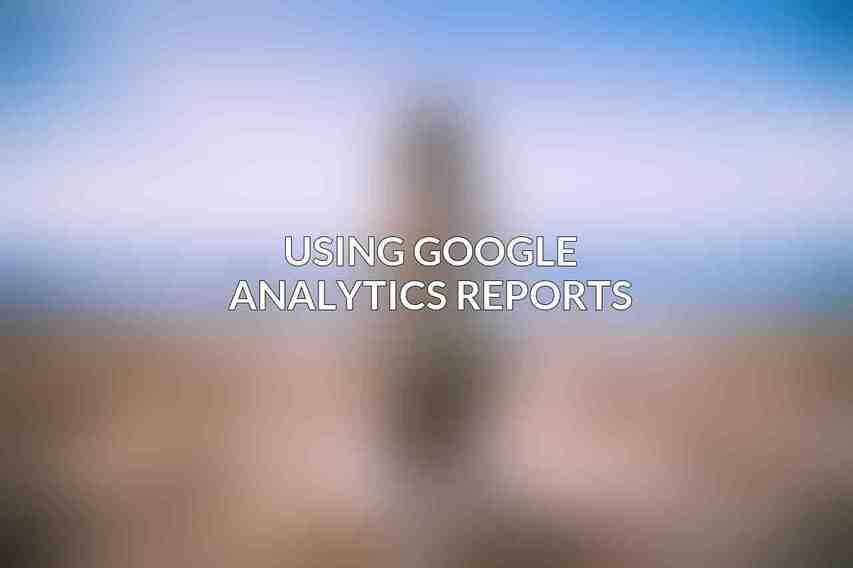Today, data-driven decision-making is crucial for the success of small businesses. Understanding customer behavior, website performance, and marketing effectiveness can significantly impact business growth and profitability. Analytics provides valuable insights into these areas, allowing small business owners to make informed decisions that drive success. One of the most widely used tools for tracking website performance and user behavior is Google Analytics.
Google Analytics is a powerful web analytics service that provides in-depth statistics about website traffic and user interactions. It offers valuable data on visitors, page views, referral sources, and conversion metrics. By leveraging Google Analytics effectively, small businesses can gain a competitive edge in their digital strategies and optimize their online presence for better results.
Getting Started with Google Analytics
Setting up Google Analytics for your small business is a relatively straightforward process that involves creating an account and integrating the tracking code into your website. By following these steps, you can start harnessing the power of data to drive your business decisions.
Creating a Google Analytics Account:
- To get started, visit the Google Analytics website and sign in with your Google account.
- Create a new account for your website and complete the setup process by providing relevant details about your business.
Adding the Google Analytics Tracking Code:
- After setting up your account, you will be provided with a tracking code snippet.
- Copy and paste this code into the HTML of your website to start monitoring visitor activity.
Setting Up Your Analytics Goals
Goals are essential metrics that help you track specific actions on your website, such as form submissions, product purchases, or newsletter sign-ups. By setting up goals in Google Analytics, you can measure the effectiveness of your online efforts and optimize your conversion rates.
Identifying Relevant Goals for Your Business:
- Determine the key actions you want visitors to take on your website that align with your business objectives.
- Examples of goals include completing a contact form, making a purchase, or spending a certain amount of time on a page.
Configuring Goal Tracking in Google Analytics:
- Navigate to the Admin section of your Google Analytics account and select Goals.
- Follow the prompts to set up your goals by defining the goal type, details, and success criteria.
Tracking Key Website Metrics
Monitoring key website metrics is crucial for understanding how users interact with your site and where improvements can be made. Some of the fundamental metrics to track in Google Analytics include pageviews, sessions, traffic sources, bounce rate, average session duration, and goal conversions.
Pageviews and Sessions:
- Pageviews indicate the total number of pages viewed by visitors on your website.
- Sessions represent the total number of visits to your site within a specific timeframe.
Traffic Sources:
- Analyze where your website traffic is coming from, whether it’s organic search, referral sites, social media, or direct visits.
Bounce Rate and Average Session Duration:
- Bounce rate measures the percentage of single-page visits where users leave without further interaction.
- Average session duration shows the average amount of time users spend on your site.
Goal Conversions:
- Track the completion of specific actions that you have defined as goals, such as making a purchase or signing up for a newsletter.
Integrating Analytics with Your Social Media

Social media plays a significant role in driving traffic to your website and engaging with your audience. By integrating Google Analytics with platforms like Facebook, Twitter, and Instagram, you can track social engagement metrics and understand how social media impacts your website performance.
Connecting with Facebook, Twitter, and Instagram:
- Utilize tools like Facebook Pixel, Twitter Analytics, and Instagram Insights to link social media data with Google Analytics.
- Set up UTM parameters to track the effectiveness of social media campaigns in Google Analytics.
Tracking Social Engagement and Traffic Sources:
- Monitor metrics such as likes, shares, comments, and click-through rates to gauge social media performance.
- Identify which social platforms drive the most traffic to your website and generate the highest conversions.
Customizing Your Analytics Dashboards
Google Analytics allows you to create custom dashboards tailored to your specific business needs. By designing personalized dashboards with relevant widgets and filters, you can easily monitor key metrics and gain insights into the performance of your website.
Creating Custom Dashboards for Easy Performance Monitoring:
- Build dashboards that provide a snapshot of your most important metrics, such as traffic volume, conversion rates, and social media impact.
- Customize the layout and design of your dashboards to prioritize the data that matters most to your business.
Adding Relevant Widgets to Track Key Metrics:
- Include widgets that display real-time data on page views, goal completions, traffic sources, and user demographics.
- Use widgets to visualize data trends and identify areas for optimization.
Using Filters to Segment Data and Analyze Specific Trends:
- Apply filters to segment your data by various criteria, such as geographical location, device type, or referral source.
- Analyze segmented data to uncover patterns, preferences, and opportunities for targeted marketing strategies.
Using Google Analytics Reports

Google Analytics offers a range of reports that provide detailed insights into your website performance, user behavior, and conversion metrics. By regularly reviewing these reports, you can identify areas of improvement and make data-driven decisions to enhance your online presence.
Accessing the Acquisition, Behavior, and Conversion Reports: Check out our insights into Decoding Analytics: How Small Businesses Can Use Data for Growth
- Explore the Acquisition report to understand how users find your website.
- Use the Behavior report to analyze user interactions with your site’s content.
- Review the Conversion report to track goal completions and measure the effectiveness of your online strategies.
Analyzing Website Traffic and User Behavior:
- Identify popular landing pages, high-traffic sources, and areas with high bounce rates.
- Analyze user flow to see how visitors navigate through your site and where they drop off.
Identifying Areas for Improvement:
- Use the data from Google Analytics reports to pinpoint weaknesses in your website’s performance.
- Implement changes based on insights to enhance user experience, optimize conversion paths, and drive business growth.
Advanced Analytics Techniques
In addition to basic tracking and reporting features, Google Analytics offers advanced techniques for deeper analysis and insight generation. E-commerce tracking, event tracking, and cohort analysis are valuable tools for understanding customer behavior and enhancing your online presence.
E-commerce Tracking for Online Sales:
- Set up e-commerce tracking in Google Analytics to monitor transactions, revenue, and product performance.
- Gain insights into customer shopping behavior, conversion rates, and revenue sources.
Event Tracking for Custom Interactions: Check out our insights into Understanding Analytics for Small Business Growth: A Beginner’s Guide
- Track specific user interactions on your website, such as clicks on buttons, video views, or file downloads.
- Measure the effectiveness of marketing campaigns and website features through event tracking data.
Cohort Analysis for Tracking Customer Behavior Over Time:
- Use cohort analysis to segment users based on common characteristics or behaviors.
- Track user retention, engagement, and conversion rates over time to identify trends and opportunities for targeted marketing.
Making Data-Driven Decisions
The true value of analytics lies in using data to drive informed decisions that align with your business goals. By leveraging analytics insights, small businesses can refine their marketing strategies, optimize website content, and improve overall business performance.
Using Analytics Data to Inform Marketing Strategies:
- Identify which marketing channels bring the highest ROI and allocate resources accordingly.
- Tailor marketing campaigns based on audience behavior, preferences, and conversion patterns.
Optimizing Website Content and User Experience:
- Analyze website data to improve content relevance, user engagement, and conversion rates.
- Implement A/B testing and user feedback mechanisms to enhance the user experience and drive conversions.
Improving Business Performance through Data-Based Insights:
- Monitor key performance indicators (KPIs) regularly to track progress towards business objectives.
- Make data-driven decisions regarding product offerings, pricing strategies, and customer targeting to drive growth and profitability.
setting up analytics for small business success involves a strategic approach to data collection, analysis, and decision-making. By following the steps outlined in this guide, small business owners can unlock the full potential of Google Analytics and leverage data to optimize their online presence.
Continuous monitoring and optimization of website performance are essential for staying competitive in this digital world. By embracing a data-driven mindset and utilizing analytics tools effectively, small businesses can make informed decisions that lead to long-term success.
For additional resources on leveraging analytics in a business context, consider exploring industry publications, online courses, and professional certification programs that focus on data analytics and digital marketing strategies.
Remember, the key to small business success lies in understanding your data and using it to drive meaningful action.
Frequently Asked Questions
What is the importance of setting up analytics for small businesses?
Setting up analytics for small businesses helps to track key metrics, make data-driven decisions, and understand customer behavior, leading to improved efficiency and profitability.
How can analytics benefit a small business?
Analytics can provide valuable insights into customer preferences, market trends, and areas for improvement, enabling small businesses to optimize their strategies and achieve growth.
What are some key analytics tools for small businesses?
Popular analytics tools for small businesses include Google Analytics, SEMrush, Hootsuite, and Canva, which can help track website traffic, social media performance, and overall marketing efforts.
How should small businesses analyze and interpret analytics data?
Small businesses should focus on setting clear goals, identifying relevant KPIs, regularly monitoring data, and using the insights gained to make informed decisions for business growth.
Do I need a dedicated analytics team to set up analytics for my small business?
While having a dedicated analytics team can be beneficial, small businesses can also leverage user-friendly analytics tools and resources, or hire external experts on a freelance basis, to set up analytics effectively.
